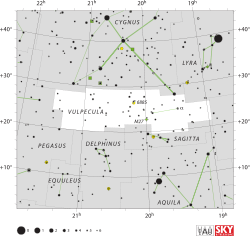27 Vulpeculae
 | |
| Observation data Epoch J2000 Equinox J2000 | |
|---|---|
| Constellation | Vulpecula |
| Right ascension | 20h 37m 04.67254s[1] |
| Declination | +26° 27′ 43.0087″[1] |
| Apparent magnitude (V) | 5.590[2] |
| Characteristics | |
| Spectral type | B9 V[3][4] |
| B−V color index | −0.050±0.004[5] |
| Astrometry | |
| Radial velocity (Rv) | −21.8±4.3[6] km/s |
| Proper motion (μ) | RA: +15.25[1] mas/yr Dec.: −11.51[1] mas/yr |
| Parallax (π) | 10.27 ± 0.29[1] mas |
| Distance | 318 ± 9 ly (97 ± 3 pc) |
| Absolute magnitude (MV) | 0.65[5] |
| Details | |
| Mass | 2.77±0.03[4] M☉ |
| Radius | 3.1[7] R☉ |
| Luminosity | 75.0+4.8 −4.5[4] L☉ |
| Surface gravity (log g) | 3.781[8] cgs |
| Temperature | 10,789+50 −49[4] K |
| Metallicity [Fe/H] | −0.27±0.04[5] dex |
| Rotational velocity (v sin i) | 335[4] km/s |
| Other designations | |
| Database references | |
| SIMBAD | data |
27 Vulpeculae is a single,[10] blue-white star in the northern constellation of Vulpecula. It is a dim star, visible to the naked eye, with an apparent visual magnitude of 5.59.[2] An annual parallax shift of 10.27±0.29 mas[1] provides a distance estimate of about 318 light years. It is moving closer with a heliocentric radial velocity of −22 km/s,[6] and will make perihelion passage at a distance of around 119 ly (36.56 pc) in 3.75 million years.[5]
This is a B-type main-sequence star with a stellar classification of B9 V.[3] It is spinning rapidly, showing a projected rotational velocity of 335.[4] The star has an estimated 2.77[4] times the mass of the Sun and about 3.1[7] times the Sun's radius. It is radiating 75[4] times the Sun's luminosity from its photosphere at an effective temperature of 10,789 K.[4]
References
- 1 2 3 4 5 6 van Leeuwen, F. (2007), "Validation of the new Hipparcos reduction", Astronomy and Astrophysics, 474 (2): 653–664, arXiv:0708.1752, Bibcode:2007A&A...474..653V, doi:10.1051/0004-6361:20078357.
- 1 2 Paunzen, E. (2015), "A new catalogue of Strömgren-Crawford uvbyβ photometry", Astronomy & Astrophysics, 580: A23, arXiv:1506.04568, Bibcode:2015A&A...580A..23P, doi:10.1051/0004-6361/201526413.
- 1 2 Cowley, A.; et al. (April 1969), "A study of the bright A stars. I. A catalogue of spectral classifications", Astronomical Journal, 74: 375–406, Bibcode:1969AJ.....74..375C, doi:10.1086/110819
- 1 2 3 4 5 6 7 8 9 Zorec, J.; Royer, F. (January 2012), "Rotational velocities of A-type stars. IV. Evolution of rotational velocities", Astronomy & Astrophysics, 537: A120, arXiv:1201.2052, Bibcode:2012A&A...537A.120Z, doi:10.1051/0004-6361/201117691.
- 1 2 3 4 Anderson, E.; Francis, Ch. (2012), "XHIP: An extended hipparcos compilation", Astronomy Letters, 38 (5): 331, arXiv:1108.4971, Bibcode:2012AstL...38..331A, doi:10.1134/S1063773712050015.
- 1 2 Gontcharov, G. A. (2006), "Pulkovo Compilation of Radial Velocities for 35 495 Hipparcos stars in a common system", Astronomy Letters, 32 (11): 759–771, arXiv:1606.08053, Bibcode:2006AstL...32..759G, doi:10.1134/S1063773706110065.
- 1 2 Pasinetti Fracassini, L. E.; et al. (2001), "Catalogue of Apparent Diameters and Absolute Radii of Stars (CADARS)", Astronomy & Astrophysics (Third ed.), 367: 521–24, arXiv:astro-ph/0012289, Bibcode:2001A&A...367..521P, doi:10.1051/0004-6361:20000451.
- ↑ Huang, W.; Gies, D. R. (August 2008), "Stellar Rotation in Field and Cluster B Stars", The Astrophysical Journal, 683 (2), arXiv:0805.2133, Bibcode:2008ApJ...683.1045H, doi:10.1086/590106, 1045–1051.
- ↑ "27 Vul". SIMBAD. Centre de données astronomiques de Strasbourg. Retrieved 2018-04-21.
- ↑ Eggleton, P. P.; Tokovinin, A. A. (September 2008), "A catalogue of multiplicity among bright stellar systems", Monthly Notices of the Royal Astronomical Society, 389 (2): 869–879, arXiv:0806.2878, Bibcode:2008MNRAS.389..869E, doi:10.1111/j.1365-2966.2008.13596.x.
External links
- 27 Vulpeculae on WikiSky: DSS2, SDSS, GALEX, IRAS, Hydrogen α, X-Ray, Astrophoto, Sky Map, Articles and images